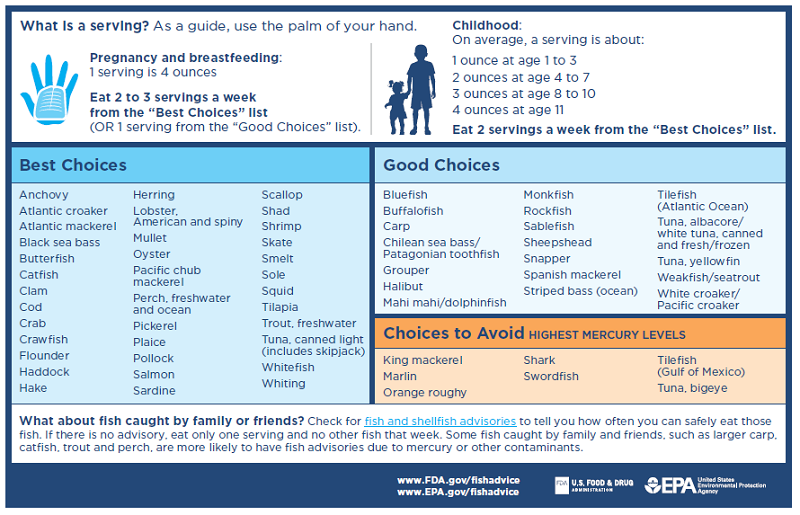Fish is good for you but mercury isn't. Watch your intake.
By UNIVERSITY OF ROCHESTER MEDICAL
CENTER
Researchers have introduced a novel approach to evaluate the neurodevelopmental effects of fish consumption during pregnancy, focusing on the balance between mercury exposure and nutritional value. This study highlights the potential benefits of consuming low-mercury fish and the risks associated with high-mercury varieties.
Nutritional Benefits and Risks of Fish Consumption During Pregnancy
It may seem simple, but fish consumption during pregnancy is a complex scientific topic. On one hand, fish are rich in nutrients essential to brain development, including polyunsaturated fatty acids, vitamin D, selenium, and iodine. On the other hand, fish contain methyl mercury, a known neurotoxicant.
This has led the US Food and Drug Administration (FDA) to
recommend that expectant mothers limit consumption, which inadvertently causes
many women to completely avoid fish consumption during pregnancy.
Advancing Research on Mercury Exposure and Fish Intake
Fish consumption is an important route of methyl mercury exposure, however, efforts to understand the health risk posed by mercury are further complicated by the fact that the nutritional benefits from fish may modify or reduce the toxicity posed by mercury.
A new study appearing in
the American Journal of Epidemiology based on data
from a cohort of residents of a coastal community in Massachusetts creates a
new framework that could untangle these questions, reduce confusion, and
produce clearer guidance on fish consumption for pregnant mothers.
A New Model to Assess Fish Consumption and
Neurodevelopment
“We propose an alternative modeling approach to address limitations of previous models and to contribute thereby to improved evidence-based advice on the risks and benefits of fish consumption,” said the authors, who include Sally Thurston, PhD, with the University of Rochester Medical Center, Susan Korrick, MD, MPH, with Harvard T.H. Chan School of Public Health and Brigham and Women’s Hospital, and David Ruppert, PhD, with Cornell University.
“In fish-eating populations, this can be addressed by separating
mercury exposure into fish intake and average mercury content of the consumed
fish.”
The new research comes from an analysis of data from the
New Bedford Cohort, which was created to assess the health of children born to
mothers residing near the New Bedford Harbor Superfund site in Massachusetts.
The current study included 361 children from the cohort who were born between
1993 and 1998 and underwent neurodevelopment assessments, including tests for
IQ, language, memory, and attention, at age eight years.
The researchers were able to measure mercury exposure
during the third trimester of pregnancy through hair sample collected from the
mothers after birth. While hair samples have been the traditional method to
study maternal mercury exposure, this approach alone cannot distinguish between
mothers who frequently consumed low-mercury fish compared to those who consumed
a smaller quantity of high-mercury fish.
Implications and Future Directions in Fish Consumption
Research
To overcome this limitation, the researchers instead created a model that includes estimates of mercury exposure per serving of fish. This was possible because mothers in the cohort also completed a food questionnaire and reported the type and frequency of fish and shellfish consumed during pregnancy.
The authors estimated the average mercury levels by
type of fish, and when combined with the information about the mother’s diet,
they were able to create a more precise and detailed method to estimate the joint
associations of pregnancy fish intake and fish mercury levels on
neurodevelopment.
Using this model, the researchers found that the relation
between pregnancy fish consumption and subsequent neurodevelopment varied
depending on the estimated average mercury levels in the fish. Specifically,
consuming low mercury-containing fish was beneficial, while consuming fish with
higher levels of mercury was detrimental.
“Given methodologic limitations to previous analyses,
future work expanding our alternative modeling approach to account for both the
average mercury and nutritional content of fish could facilitate better
estimation of the risk-benefit tradeoffs of fish consumption, a key component
of many healthy diets,” said the authors.
The authors are in the process of applying this model to
other large studies of maternal fish consumption, including the Seychelles Child Development Study, in which
Thurston serves on as an investigator.
Reference: “A Novel Approach to Assessing the Joint
Effects of Mercury and Fish Consumption on Neurodevelopment in the New Bedford
Cohort” 28 June 2024, American Journal of
Epidemiology.
DOI: 10.1093/aje/kwae149
The American Journal of
Epidemiology study was supported with funding from the National
Institute of Environmental Health Sciences.
